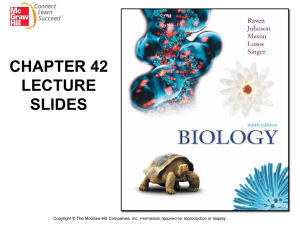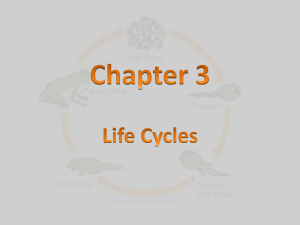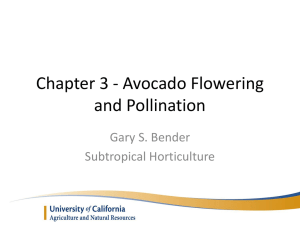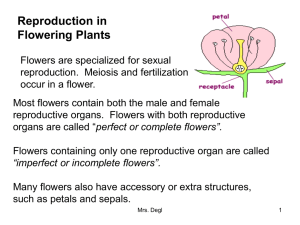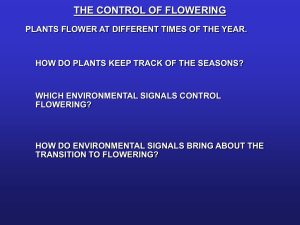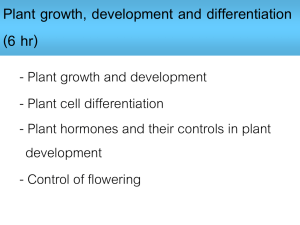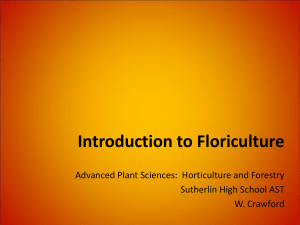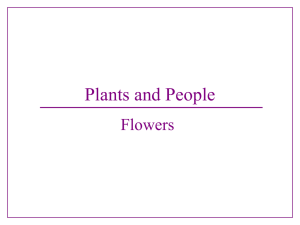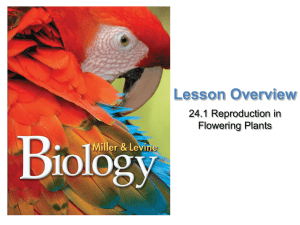chapt42_lecture_anim_ppt
advertisement
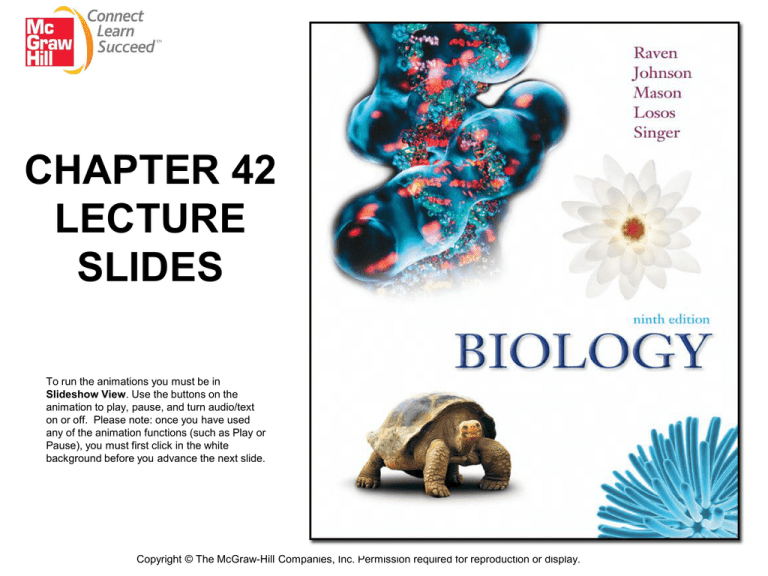
CHAPTER 42 LECTURE SLIDES To run the animations you must be in Slideshow View. Use the buttons on the animation to play, pause, and turn audio/text on or off. Please note: once you have used any of the animation functions (such as Play or Pause), you must first click in the white background before you advance the next slide. Copyright © The McGraw-Hill Companies, Inc. Permission required for reproduction or display. Plant Reproduction Chapter 42 Reproductive Development • Angiosperms represent an evolutionary innovation with their production of flowers and fruits • Plants go through developmental changes leading to reproductive maturity by adding structures to existing ones with meristems • A germinating seed becomes a vegetative plant through morphogenesis 3 4 Reproductive Development • Once plants are competent to reproduce, a combination of factors – including light, temperature, and both promotive and inhibitory internal signals – determines when a flower is produced • Undergo phase change – subtle or obvious 5 • In oak trees, lower branches (juvenile phase) cling to their leaves in the fall • Only juvenile ivy makes adventitious roots 6 Reproductive Development • Flowering is the default state • Many mechanisms have evolved to delay flowering • In Arabidopsis, the gene embryonic flower (emf) prevents early flowering – emf mutants flower immediately 7 Reproductive Development • The juvenile-to-adult transition can be induced by overexpressing a flowering gene • LEAFY (LFY) was cloned in Arabidopsis • Overexpression of LFY in aspen causes flowering to occur in weeks instead of years 8 Flower Production • Four genetically regulated pathways to flowering have been identified 1. 2. 3. 4. The light-dependent pathway The temperature-dependent pathway The gibberellin-dependent pathway The autonomous pathway • Plants can rely primarily on one pathway, but all four pathways can be present 9 Light-Dependent Pathway • Also termed the photoperiodic pathway • Keyed to amount of dark in the daily 24-hr cycle (day length) • Short-day plants flower when daylight becomes shorter than a critical length • Long-day plants flower when daylight becomes longer • Day-neutral plants flower when mature regardless of day length 10 11 Light-Dependent Pathway • In obligate long- or short-day plants there is a sharp distinction between short and long nights, respectively • In facultative long- or short-day plants, the photoperiodic requirement is not absolute – Flowering occurs more rapidly or slowly depending on the length of day 12 Light-Dependent Pathway • Using light as a cue allows plants to flower when abiotic conditions are optimal • Manipulation of photoperiod in greenhouses ensures that short-day poinsettias flower in time for the winter holidays 13 Light-Dependent Pathway • Conformational change in a phytochrome (red-light sensitive) or cryptochrome (bluelight sensitive) light-receptor molecule triggers a cascade of events that leads to the production of a flower • In Arabidopsis, regulate via the gene CONSTANS (CO) • Phytochrome regulates the transcription of CO 14 Light-Dependent Pathway • CO protein is produced day and night – Levels of CO are lower at night because of targeted protein degradation by ubiquitin – Blue light acting via cryptochrome stabilizes CO during the day and protects it from ubiquitination • CO is a transcription factor that turns on other genes – Results in the expression of LFY – LFY is one of the key genes that “tells” a meristem to switch over to flowering 15 Please note that due to differing operating systems, some animations will not appear until the presentation is viewed in Presentation Mode (Slide Show view). You may see blank slides in the “Normal” or “Slide Sorter” views. All animations will appear after viewing in Presentation Mode and playing each animation. Most animations will require the latest version of the Flash Player, which is available at http://get.adobe.com/flashplayer. 16 Temperature-Dependent Pathway • Some plants require a period of chilling before flowering – vernalization – Necessary for some seeds or plants in later stages of development • Analysis of plant mutants reveals that vernalization is a separate flowering pathway 17 Autonomous Pathway • Does not depend on external cues except for basic nutrition • Allows day-neutral plants to “count” and “remember” • Tobacco plants produce a uniform number of nodes before flowering • Upper axillary buds of flowering tobacco remember their position if rooted or grafted 18 • Plants can “count” • If the shoots of these plants are removed at different positions, axillary buds will grow out and produce the same number of nodes as the removed portion of the shoot 19 • Plants can “remember” • Upper axillary buds of flowering tobacco will remember their position when rooted or grafted • Terminal shoot tip becomes committed, or determined, to flower about four nodes before it actually initiates a flower 20 Autonomous Pathway • How do shoots “count” and “remember”? • Experiments using bottomless pots have shown that it is the addition of roots, and not the loss of leaves, that inhibits flowering • Clear that inhibitory signals are sent from the roots • A balance between floral promoting and inhibiting signals may regulate flowering 21 • Addition of roots, and not the loss of leaves, delays flowering 22 Model for Flowering • 4 flowering pathways lead to an adult meristem becoming a floral meristem – Activate or repress the inhibition of floral meristem identity genes • 2 key genes: LFY and AP1 – Turn on floral organ identity genes – Define the four concentric whorls • Sepal, petal, stamen, and carpel 23 24 ABC Model • Explains how 3 classes of floral organ identity genes can specify 4 distinct organ types 1. 2. 3. 4. Class A genes alone – Sepals Class A and B genes together – Petals Class B and C genes together – Stamens Class C genes alone – Carpels • When any one class is missing, aberrant floral organs occur in predictable positions 25 26 27 Modifications to ABC Model • ABC model cannot fully explain specification of floral meristem identity • Class D genes are essential for carpel formation • Class E genes SEPALATA (SEP) – SEP proteins interact with class A, B, and C proteins that are needed for the development of floral organs • Modified ABC model was proposed 28 29 Flower Structure • Floral organs are thought to have evolved from leaves • A complete flower has four whorls – Calyx, corolla, androecium, and gynoecium • An incomplete flower lacks one or more of the whorls 30 Flower Structure • Calyx = Consists of flattened sepals • Corolla = Consists of petals • Androecium = Collective term for stamens – Stamen consists of a filament and an anther • Gynoecium = Collective term for carpel(s) – Carpel consists of ovary, style, and stigma – Ovules produced in ovary 31 Male structure Female structure 32 Trends in Floral Specialization • 2 major trends 1.Separate floral parts grouped or fused 2.Floral parts lost or reduced • Wild geranium • Modifications often relate to pollination mechanisms 33 Trends in Floral Specialization • Floral symmetry • Primitive flowers are radially symmetrical • Advanced flowers are bilaterally symmetrical – Orchid 34 Gamete Production • Alternation of generations • Diploid sporophyte haploid gametophyte • In angiosperms, the gametophyte generation is very small and is completely enclosed within the tissues of the parent sporophyte – Male gametophyte – pollen grains – Female gametophyte – embryo sac 35 Gamete Production • Gametes are produced in separate, specialized structures of the flower • Reproductive organs of angiosperms differ from those of animals in two ways 1. Both male and female structures usually occur together in the same individual 2. Reproductive structures are not permanent parts of the adult individual 36 37 Pollen Formation • Anthers contain four microsporangia which produce microspore mother cells (2n) • Microspore mother cells produce microspores (n) through meiosis • Microspore develops by mitosis into pollen • Generative cell in the pollen grain will later divide to form two sperm cells 38 Embryo Sac Formation • Within each ovule, a diploid microspore mother cell undergoes meiosis to produce four haploid megaspores • Usually only one megaspore survives • Enlarges and undergoes repeated mitotic divisions to produce eight haploid nuclei • Enclosed within a seven-celled embryo sac 39 40 Pollination • Process by which pollen is placed on the stigma • Self-pollination – Pollen from a flower’s anther pollinates stigma of the same flower • Cross-pollination – Pollen from anther of one flower pollinates another flower’s stigma – Also termed outcrossing 41 Pollination • Successful pollination in many angiosperms depends on regular attraction of pollinators • Floral morphology has coevolved with pollinators • Early seed plants wind pollinated • Among insect-pollinated angiosperms, the most numerous groups are those pollinated by bees 42 Pollination • Bees typically visit yellow or blue flowers • Many have stripes or lines of dots that indicate the location of the nectaries • Bull’s-eye visible to bees 43 Pollination • Flowers that are visited regularly by butterflies often have flat “landing platforms” • Flowers that are visited regularly by moths are often white or pale in color • Also tend to be heavily scented • Easy to locate at night 44 Pollination • Flowers that are visited regularly by birds must produce large amounts of nectar • Often have a red color • Usually inconspicuous to insects 45 Pollination • Some angiosperms are wind-pollinated – Characteristic of early seed plants • Flowers are small, green, and odorless, with reduced or absent corollas • Often grouped and hanging down in tassels • Stamen- and carpel-containing flowers are usually separated between individuals – Strategy that greatly promotes outcrossing 46 47 Pollination • Outcrossing is highly advantageous for plants and for eukaryotic organisms generally • 2 basic reasons for frequency of selfpollination 1. Self-pollination is favored in stable environments 2. Offspring are more uniform and probably better adapted to their environment 48 Pollination • Several evolutionary strategies promote outcrossing – Separation of male and female structures in space • Dioecious plants produce only ovules or only pollen • Monoecious plants produce male and female flowers on the same plant – Self-incompatibility that prevents selffertilization 49 Copyright © The McGraw-Hill Companies, Inc. Permission required for reproduction or display. 2 1 a. b. 3 1. Bee starts at bottom, encountering older, pistillate flowers. 2. Bee moves up the stalk, encountering younger staminate flowers with pollen. Once it runs out of flowers to visit, it flies to a new stalk. 3. Bee starts at bottom, bringing pollen to the older pistillate flowers. a: © David Sieren/Visuals Unlimited; b: © Barbara Gerlach/Visuals Unlimited • Even if functional stamens and pistils are both found in the same flower, they may reach maturity at different times • Plants in which this occurs are called dichogamous 50 Pollination • Self-incompatibility increases outcrossing • Pollen and stigma recognize each other as self and pollen tube growth is blocked • Controlled by alleles at the S locus • 2 types of self-incompatibility 1. Gametophytic self-incompatibility • Depends on the haploid S locus of the pollen and the diploid S locus of the stigma 2. Sporophytic self-incompatibility • If the alleles in the stigma match either of the pollen parent’s S alleles, the haploid pollen will not germinate 51 Pollination Determined by the haploid pollen genotype Determined by the genotype of the diploid pollen parent 52 Double fertilization • Only in angiosperms • Double fertilization results in two key developments – Fertilization of the egg – Formation of endosperm that nourishes the embryo • Fuses with 2 polar nuclei in embryo sac to form 3n endosperm 53 54 55 Asexual Reproduction • Produces genetically identical individuals because only mitosis occurs • More common in harsh environments – All clones are adapted – Variations may not be adapted • Apomixis – asexual development of a diploid embryo in the ovule – Gain advantage of seed dispersal usually associated with sexual reproduction 56 Asexual Reproduction • Vegetative reproduction – New plant individuals are cloned from parts of adults – Comes in many and varied forms • • • • Runners or stolons Rhizomes Suckers Adventitious plantlets 57 Asexual Reproduction • Whole plants can be cloned by regenerating plant cells or tissues on nutrient medium • Individual cell isolated and cell wall removed – Protoplast – plant cell with only plasma membrane • Many, but not all, cell types in plants maintain the ability to generate organs or an entire organism in culture • Cells divide in culture to form a callus 58 Copyright © The McGraw-Hill Companies, Inc. Permission required for reproduction or display. a. 100 µm 59 a: © Sinclair Stammers/Photo Researchers, Inc Copyright © The McGraw-Hill Companies, Inc. Permission required for reproduction or display. a. 100 µm b. a: © Sinclair Stammers/Photo Researchers, Inc.; b:From N. Kuchuk, R. G. Herrmann and H.-U. Koop, “Plant regeneration from leaf protoplasts of evening primrose (Oenothera hookeri),” Plant Cell Reports, Vol. 17, Number 8, pp. 601-604 © 5 May 1998 Springer 1 µm 60 Copyright © The McGraw-Hill Companies, Inc. Permission required for reproduction or display. a. 100 µm b. 1 µm c. 1 µm a: © Sinclair Stammers/Photo Researchers, Inc.; b:From N. Kuchuk, R. G. Herrmann and H.-U. Koop, “Plant regeneration from leaf protoplasts of evening primrose (Oenothera hookeri),” Plant Cell Reports, Vol. 17, Number 8, pp. 601-604 © 5 May 1998 Springer 61 Copyright © The McGraw-Hill Companies, Inc. Permission required for reproduction or display. a. 100 µm b. 1 µm c. 1 µm d. 1 µm a: © Sinclair Stammers/Photo Researchers, Inc.; b:From N. Kuchuk, R. G. Herrmann and H.-U. Koop, “Plant regeneration from leaf protoplasts of evening primrose (Oenothera hookeri),” Plant Cell Reports, Vol. 17, Number 8, pp. 601-604 © 5 May 1998 Springer 62 Plant Life Spans • Once established, plants live for variable periods of time, depending on the species • Woody plants, which have extensive secondary growth, typically live longer than herbaceous plants, which don’t – Bristlecone pine, for example, can live upward of 4000 years • Depending on the length of their life cycles, herbaceous plants may be annual, biennial, or perennial 63 Copyright © The McGraw-Hill Companies, Inc. Permission required for reproduction or display. a. 64 © Anthony Arendt/Alamy Copyright © The McGraw-Hill Companies, Inc. Permission required for reproduction or display. a. b. a: © Anthony Arendt/Alamy; b: © DAVID LAZENBY/Animals Animals - Earth Scenes 65

